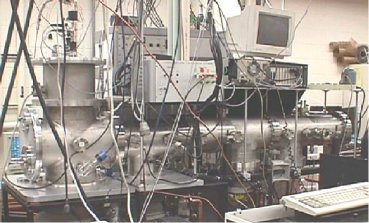Cluster Spectroscopy
The group has also directed its efforts toward photodissociation processes in mass-selected clusters. The group employs time of flight (TOF) mass spectrometry and laser photodissociation spectroscopy to probe the absorption spectra of clusters produced in a laser vaporization source. Absorption spectra, acquired by measuring photofragment intensities as a function of photolysis wavelength at a selected mass, provide information on the electronic properties of the clusters. Our efforts have been devoted to understanding processes of solvent evaporation and reaction in clusters of singly-charged alkaline earth cations solvated by the polar solvent molecules NH3, H2O, CH3OH, CH3NH2, and their isotopomers.
A comparison of the spectra for strontium cations solvated by NH3, H2O, and CH3OH and the analogous magnesium systems, shows a similar pattern of behavior. Large red shifts occur with increasing numbers of first-shell solvent molecules, but the shifts appear to saturate when the first shell closes. A picture appears to be emerging suggesting that such spectra provide evidence for the formation of contact and solvent-separated ion pair species that serve as precursors to solvated electron formation.
More recent work has focused on studying clusters that contain more than one Rydberg center. Our recent work has shown that clusters formed from Sr+ solvated with at least 12 NH3 molecules acquire excess hydrogen atoms. In deuterium-labelled clusters with the stoichiometry Sr+(ND3)nDx, we have obtained both chemical and spectroscopic evidence that the excess D atoms can bind in two chemically distinct sites. Spectroscopic evidence indicates that such clusters contain a metal-D core that accounts for a single excess deuterium atom. The remaining D atoms are surface bound as solvated ammonium radicals having the stoichiometry ND4(ND3)n.
